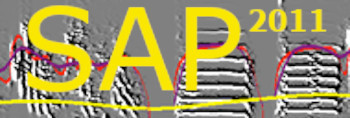Duration of acoustic state estimates the duration in milliseconds, before and after a reference point, where the acoustic structure is similar to the reference.
Isolate song syllables and notes are often prolonged and monotonic. To quantify this notion, SAP2011 estimated correlation time, namely, the interval where acoustic features remain highly correlated. Song correlation time can be calculated by computing the spectral auto-correlation of the song bout, and measuring the intervals, starting from the diagonal of the auto-correlation matrix, where the correlation coefficient (r) is higher than a certain threshold. However, during noisy sounds (e.g., a long monotonic buzz), spectral correlation time is short, even though articulatory state probably remains unchanged during a monotonic noisy sound. Using features that correlate with the articulatory state can provide better estimates of correlation time. We therefore calculated the duration of acoustic state based on pitch, FM, Wiener entropy & Goodness of pitch. SAP2011 use an algorithm developed originally to calculate the period of repetition in songs.Briefly, we scale the features to units of statistical distances based on wild type zebra finch feature distribution. We then construct a similarity matrix based on Euclidian distance between features calculated every 1 ms. Thereafter, computation of correlation time is similar to that of spectral auto-correlation matrix. We used a threshold of 2.5 Median Absolute Deviation
Duration of acoustic state Isolate song syllables and notes are often prolonged and monotonic. To quantify this notion, we estimated correlation time, namely, the interval where acoustic features remain highly correlated. Song correlation time can be calculated by computing the spectral auto-correlation of the song bout, and measuring the intervals, starting from the diagonal of the auto-correlation matrix, where the correlation coefficient (r) is higher than a certain threshold. However, during noisy sounds (e.g., a long monotonic buzz), spectral correlation time is short, even though articulatory state probably remains unchanged during a monotonic noisy sound. Using features that correlate with the articulatory state can provide better estimates of correlation time. We therefore calculated the duration of acoustic state based on pitch, FM, Wiener entropy & Goodness of pitch. We used an algorithm developed earlier6 to calculate the period of repetition in songs. Briefly, we scaled the features to units of statistical distances based on WT zebra finch feature distribution. We then constructed a similarity matrix based on Euclidian distance between features calculated every 1 ms. Thereafter, computation of correlation time is similar to that of spectral auto-correlation matrix, but based on features rather than on full spectrum.
